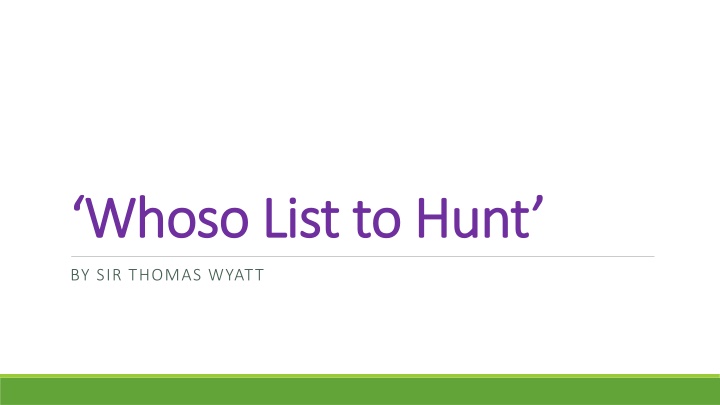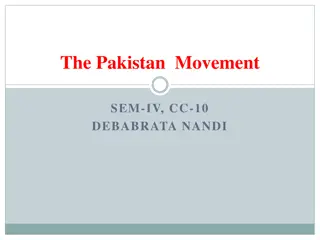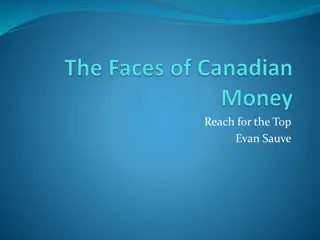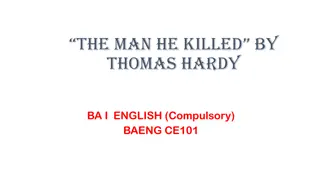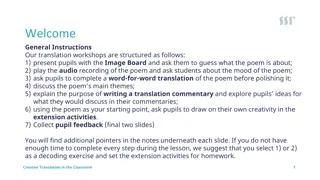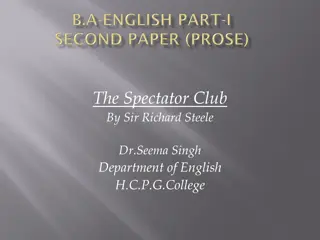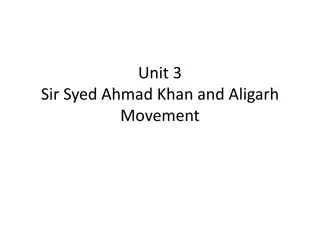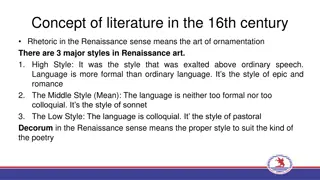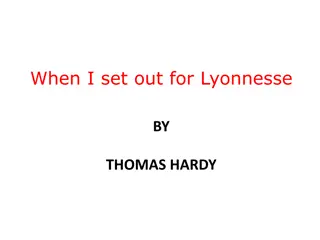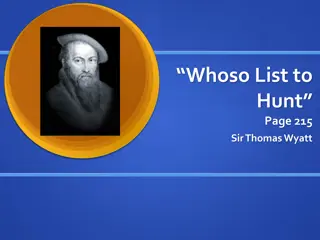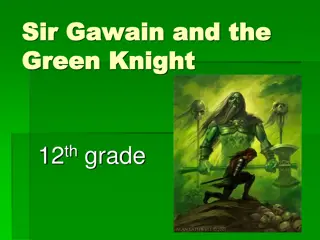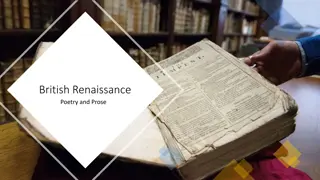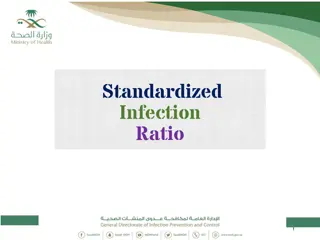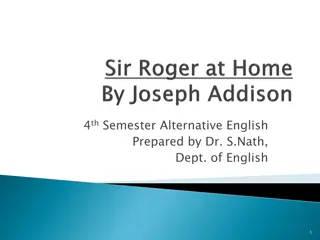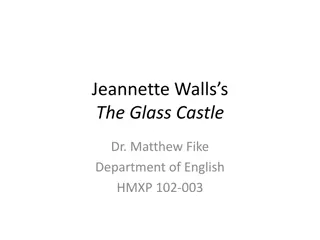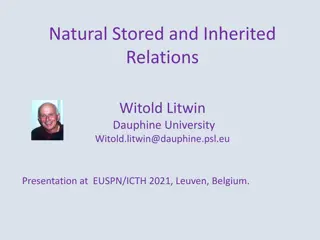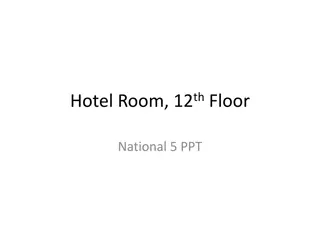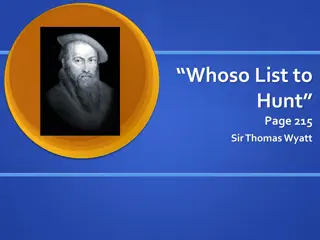Analysis of Sir Thomas Wyatt's Poem "Whoso List to Hunt
Sir Thomas Wyatt's poem "Whoso List to Hunt" serves as a metaphorical exploration of pursuit and unattainable love, possibly inspired by his interactions with Anne Boleyn. The poem intricately depicts the speaker's futile pursuit of a deer, symbolizing a woman. Through an octave and sestet structure, Wyatt conveys themes of longing, restriction, and the constraints of power. The contextual background of Wyatt's relationship with Boleyn adds a layer of complexity to the poem's interpretation, offering insight into the poet's personal experiences and emotions.
Download Presentation

Please find below an Image/Link to download the presentation.
The content on the website is provided AS IS for your information and personal use only. It may not be sold, licensed, or shared on other websites without obtaining consent from the author.If you encounter any issues during the download, it is possible that the publisher has removed the file from their server.
You are allowed to download the files provided on this website for personal or commercial use, subject to the condition that they are used lawfully. All files are the property of their respective owners.
The content on the website is provided AS IS for your information and personal use only. It may not be sold, licensed, or shared on other websites without obtaining consent from the author.
E N D
Presentation Transcript
Whoso List to Hunt Whoso List to Hunt BY SIR THOMAS WYATT
Whoso List to Hunt BY SIR THOMAS WYATT Whoso list to hunt, I know where is an hind, But as for me, alas, I may no more. The vain travail hath worried me so sore, I am of them that farthest cometh behind. Yet may I, by no means, my wearied mind Draw from the deer, but as she fleeth afore Fainting I follow. I leave off, therefore, Since* in a net I seek to hold the wind. Who list her hunt, I put him out of doubt, As well as I, may spend his time in vain. And graven with diamonds in letters plain There is written, her fair neck round about, "Noli me tangere, for Caesar's I am, And wild for to hold, though I seem tame.
Context Poem about Anne Boleyn Anne Boleyn was executed in 1536. Why? Accused of infidelity whilst married to Henry VIII. Henry VIII also wanted to marry Jane Seymore. Also, Anne Boleyn couldn t give Henry VIII a son and heir. It was rumoured that she had some kind of relationships with Sir Thomas Wyatt in the 1520s (before her marriage to Henry VIII). In 1536 Wyatt imprisoned in the Tower of London for possibly committing adultery with Anne Boleyn. He was set free. Wyatt was not allowed to pursue Anne Boleyn and critics presume this poem is about her: she is the hind that he can no longer hunt.
Wyatts poems Many of them were published posthumously in 1557 (Wyatt: 1503 1542) including this one. A lot of his poems were translations and imitations of Petrarchan sonnets rhyme scheme but he also wrote his own and changed the rhyme scheme in the sestet. Petrarchan typically has an octave of: abba abba and varying sestets. Wyatt typically wrote: abba abba cddc ee and some call this the English sonnet (Shakespeare used it) He contributed to the English sonnet rhyme scheme: three quatrains and a rhyming couplet. Petrarchan sonnets are traditionally written from the point of view of a man longing for a woman to return his love. Octave establishes/describes a problem volta/turn sestet resolves or reflects on the problem. Is this the case is Whoso list to .. ? Is the unattainable love shown at the start with the specific description in the sestet ?
The poem: The poem is a metaphor for the pursuit of a woman. Whoso list to hunt, I know where is an hind, But as for me, alas, I may no more. The vain travail hath worried me so sore, I am of them that farthest cometh behind. Yet may I, by no means, my wearied mind Draw from the deer, but as she fleeth afore Fainting I follow. I leave off, therefore, Since in a net I seek to hold the wind. This is the octave: what is being said?
The poem: The poem is a metaphor for the pursuit of a woman. Who list her hunt, I put him out of doubt, As well as I, may spend his time in vain. And graven with diamonds in letters plain There is written, her fair neck round about, "Noli me tangere*, for Caesar's I am, And wild for to hold, though I seem tame. *"Touch me not; I am Caesar's. The sestet: what is being said?
Greek & Roman Mythology Goddess Diana (heavenly or divine) depicted with a deer Goddess of hunting and virginity. One of three maiden goddesses who swore never to marry. Diana is reflected in her connection with light, inaccessibility and virginity. Contextual connotations of a deer? An elegant creature? Majestic? One for the higher classes?
Analysing the poem Form: Points about Petrarchan sonnet, typicalities, the pursuit of a woman. Atypical in the sense that he does not refer to this pursuit through courtly love but instead using the allegory of hunting, describing her as a deer. The woman has more personality and wildness in this sonnet than in usual sonnets where the woman is compared to a beautiful but inanimate object. Relates to masculine desire and ownership. Structure: Look at the syntax of the lines withholding information and building suspense within the poem, just as in a hunt therefore, identify any key lines with caesura breaks and enjambment. What does the final rhyming couplet suggest? Metre: irregular! Mostly iambic pentametre but some lines have a different number of syllables, why might this be? Language: Identify language that relates to: - Possession - love courtly or romantic - hyperbolic - semantic field of hunting - use of personal pronouns
AO5 Poem can be seen as a comment on the Tudor court of Henry VIII and the role Anne Boleyn played in it OR the end of a relationship. The reference in the poem is to Caesar (king/emperor) Caesar was, like Henry, a leader early in late teens, a handsome and strong young man and was significant in the political and aesthetic changes and developments of his realm. Both were literate, charismatic and influential. However, other less favorable parallels can be drawn. Both Caesar and Henry VIII incurred huge debt during their respective offices. There were many subjects who were held captive, sometimes executed, on charges of treason. Caesar faced questions regarding his unsuitable choices of women. Wyatt may also be alluding to these less appealing aspects of Caesar in his comparison if we see the passion in the poem to be borne of frustration and anger Most critics ,because of this context, see the poem, as about Anne Boleyn. However it does make points about the way women are seen and the failure of the pursuit of an objectified woman.
Homework: due Monday 5thFeb Plan and answer the question: Examine the view that Sir Thomas Wyatt presents women as possessions in this poem. Paragraph Point & AOx 1 intro Pursuing woman through the allegory of hunting immediately objectifies women and makes them appear as a possession however, setting limits Wyatt s ability to freely express and he may have other aims. 2 form (AO2) Pursuit of woman typical (AO4) atypical hunting possession/objectifies women (AO5 alternative and feminist reading) atypical comparison (AO4 Shakespearean sonnet) Line 1 & 9 whoever hunts her volta (AO2 st) 3 language (AO2 L and St) Semantic field of hunting read throughout(AO4-Petrarchan poem) However, link to goddess of hunting elevates woman in the poem (AO5) make contextual link about Wyatt and Anne Boleyn (AO3) 4 Context AO3 and AO4 and AO5 Contextual link to Henry VIII / Caesar / diamonds engraved aim to be critical of king rather than objectify women (AO2 L & AO3) (AO4-Petrarchan sonnet). How sonnet is interpreted
Homework: due Monday 5thFeb Plan and answer the question: Examine the view that Sir Thomas Wyatt presents women as possessions in this poem AO4 Practice Point: 1. Atypical portrayal of love hunting contrast courtly love and compare to Renaissance love poems (Sonnet 116?) 2. Elevates the woman s status sonnet form typicality links to other ideas about love in texts about love that you have read ?
